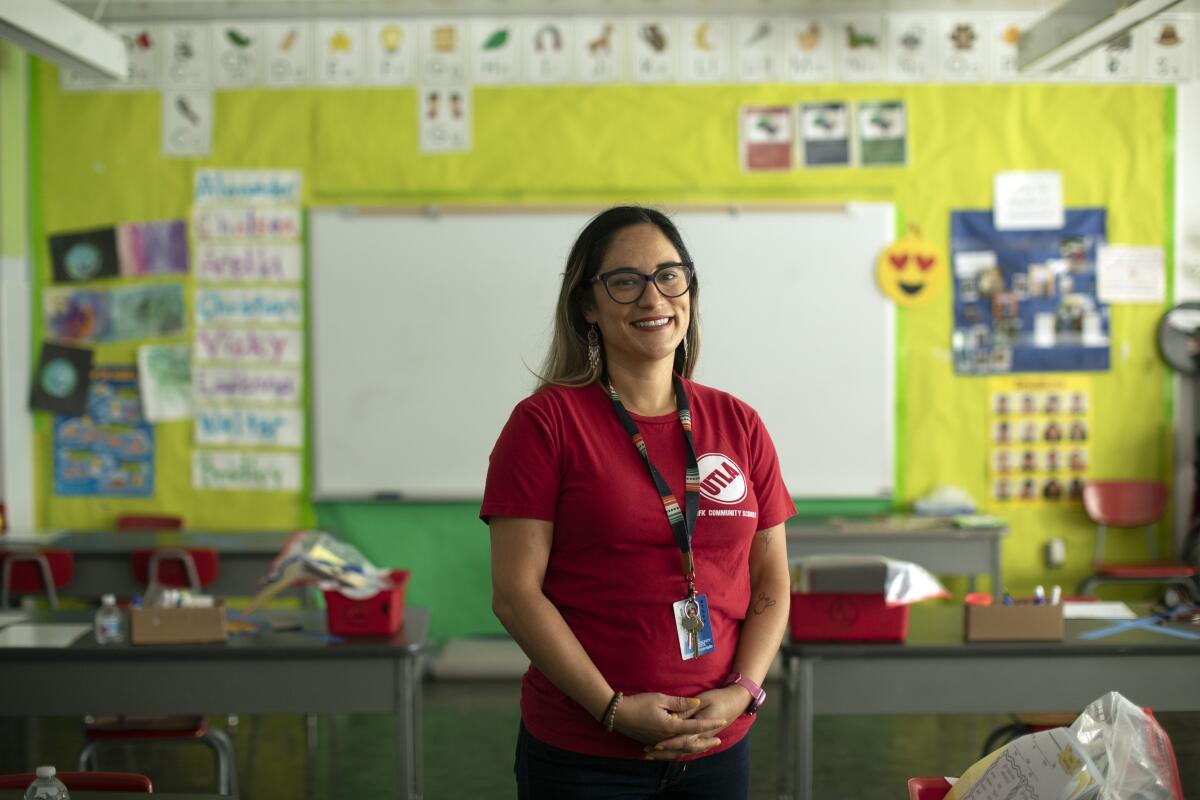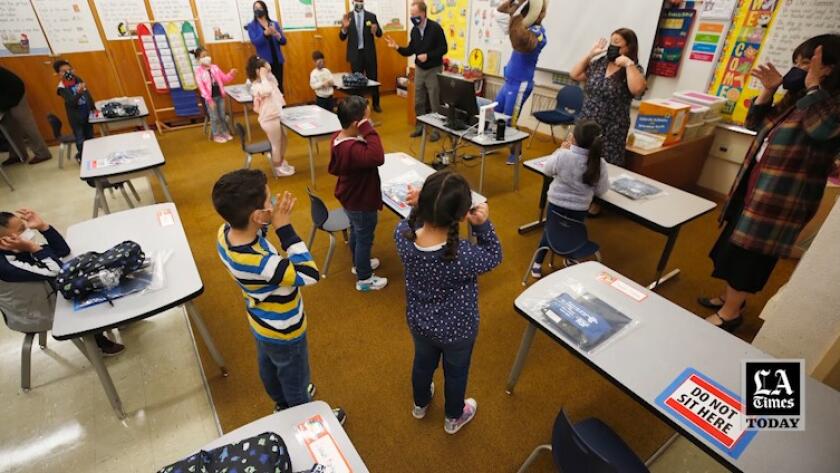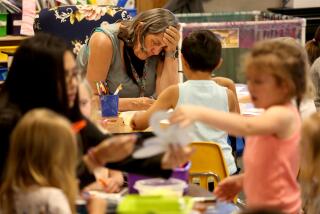Schools face mental health crisis among students as pandemic trauma remains

Before the pandemic, Jessica Bibbs-Fox’s eighth-graders would parade into her classroom bursting with energy. “Settle down,” she’d playfully shout over the clamor of voices.
Now, Room 18 at Kelly Elementary is eerily quiet. Her 14 pupils are cordoned off by plexiglass shields. She pleads with them to participate during a math lesson — to say something, anything. The 20 students she teaches on Zoom are just as withdrawn. They turn in work sporadically, if at all. Every single student in her homeroom class has an F.
Bibbs-Fox, a Compton Unified School District teacher of 17 years, understands why this is happening. Many of her students have lost family members to COVID-19; their parents have lost jobs. They’ve stood in food lines. She can imagine the anxiety-tinged conversations at home over the last year about rent payments, sickness, police brutality and protests.
And she, too, is agonizing over what to do. She received one hour of mental health training during the last year, and relatively little overall during the span of her career.
“I’m not prepared to handle all the different varieties of trauma,” Bibbs-Fox said. “And yet I’m being held responsible for it. It’s a stress I can’t even describe.”
As the first responders of the school environment, K-12 educators such as Bibbs-Fox feel that they are ill-equipped and need more tools and training to navigate their students’ often crushing mental health challenges such as anxiety and depression brought on or exacerbated by the pandemic.
The overwhelming stresses of the last 14 months have magnified a long-simmering crisis of mental health struggles among students. Hospitals across the U.S. reported an alarming increase in attempted and completed suicides among youth. The rate of children ages 11 through 17 who were screened in 2020 for anxiety and depression was 9% higher than in 2019, according to a Mental Health America report.
Relatively few teachers have been adequately trained to spot the signs of trauma and respond to it appropriately, mental health advocates say. Currently, there is no mandated mental health training for K-12 teachers, according to the California Department of Education.
At many schools in Southern California, teachers say it can take weeks for a student to connect with a counselor or social worker. The state’s average student-to-counselor ratio for the 2019-20 school year was 601 to 1, according to the American School Counselor Assn. — more than twice the recommended ratio.
Traumatic stress in children can be triggered by an overwhelming or frightening experience that threatens a child’s ability to cope with day-to-day life, psychologists say. It can also be caused by a series of events over a longer period of time, known as complex trauma.
During the pandemic, food and financial insecurity, exposure to death and illness, prolonged isolation and fear of contracting the virus have triggered traumatic stress. Youth of color from hard-hit communities are particularly vulnerable. Common symptoms of such stress among children include irritability or emotional outbursts, acting hopeless or withdrawn, and difficulty paying attention or retaining new information, therapists say.
While reopened schools provide optimism that the worst of the pandemic is over, returning students must readjust to a social environment and a structured schedule, on top of the pressure to make up for learning losses. And teachers will need to navigate the varied ways students will respond to that stress — whether they are prepared to or not.
“You can say ‘That’s not my job,’ but when the trauma is sitting in front of an educator in history class, in circle time, and they don’t feel like you have the skills to address it — it’s completely debilitating,” said Robin Gurwitch, a psychologist and psychiatry professor at Duke University who studies how to support children in the aftermath of disasters.
Educators in California are required to undergo annual training on how to recognize and report child abuse, and through this basic knowledge of childhood trauma is given.
Otherwise, it is up to California school districts or individual schools to decide what kind of mental health training they will provide to teachers. And there are limited professional development hours amid an onslaught of competing interests, namely updated curriculum standards and now the physical safety of students.
Teachers shouldn’t be expected to take on the role of counselor, advocates say. But ideally, they should be able to identify signs of trauma and respond in a way that creates a safe and nurturing environment for their students. This includes modeling emotional regulation in times of stress; giving children an opportunity to express feelings of anxiety and fear; and establishing empathic bonds with students by truly listening to them.
“Even just saying something like, ‘I understand you’re having a really hard time. I know that this is not how you usually are,’ can make a big difference,” said Marleen Wong, a social work professor at USC and an expert on school crisis response.
And yet even advocates for such training within academia say that their hands are tied. Credentialing programs already have jam-packed curriculums that prioritize teaching practices sensitive to equity and diversity, said Tomás Galguera, professor of education at Mills College. It’s a lot to fit into a single year.
“For people like me who have to prepare such teachers, we have to choose — what is most immediately necessary for these folks who are going to go on to teach?” Galguera said.
Students’ outbursts, sadness
Kindergarten and first-grade teacher Jesenia Chavez over the last year has watched hardship engulf her students, many of whom are immigrants who entered the country without visas. They’ve become increasingly sad and withdrawn as their families face evictions, deportation hearings and the death of loved ones to COVID-19.
The seven students she began teaching in person last month at UCLA Community School in Koreatown are thirsty for connection and need a lot of one-on-one care. One girl darts outside to the playground any chance she gets. A boy came to class for two days and then didn’t return. The new routine overwhelmed him.
Online, half of her pupils keep their cameras off. Participation on Zoom is nearly nonexistent; she will give instructions once, twice, five times, to no avail. “Can you all show me your work?” Chavez will ask. If she’s lucky, a single student will hold up a worksheet.
When she calls on individual students, asking them why they aren’t doing work, they log off. So she tries to be as entertaining as possible, interspersing math and reading lessons with interactive games in a desperate attempt to inspire her 6-year-olds.
Chavez is afraid that they will completely disengage if she pushes them too hard, or that she will further harm their fragile psyches. She recognizes that the ever-growing waitlist for students to connect with her school’s social worker makes it all the more vital for her to know how to respond to students’ emotional outbursts or disengagement.
“You can’t teach if you have six kids screaming in the corner,” Chavez said. She anticipates this could be a likely scenario in the fall.
Chavez’s employer, L.A. Unified School District, launched an hourlong module on trauma-informed school communities in 2020. The district has also offered access to 20 hours of online trainings on crises and mental health behaviors, which are encouraged but not required.
“The training is available, but they’re like, do it on your off time,” Chavez said. “They aren’t creating the space and time for us to do it.”
Funding boost brings hope
The pandemic has propelled a push in recent years for teachers to become better trained in trauma-informed practices.
State Sen. Anthony Portantino (D-La Cañada Flintridge) introduced a bill in December that would require at least half of each school’s staff to participate in an evidence-based mental health training program. And teachers unions are increasingly recognizing the importance of such training.
A flood of financial resources is pouring in to help. Gov. Gavin Newsom announced this month that schools will receive a massive influx of funding — $4 billion for youth mental health support, $3.3 billion for teacher and school employee training, and $3 billion for “community schools,” where education is integrated with healthcare and mental health services.
And social-emotional learning has taken on greater prominence in teacher credentialing curriculum. When deftly incorporated into the school day, teachers empower students to build supportive relationships and show them how to identify and manage their emotions. But it is distinct from being able to recognize and respond to the signs of trauma.
“Let’s say you create the culture for someone to share. They share. What do you do now?” Bibbs-Fox said. “These kids got real issues, real problems.”
Some districts are confronting this issue head-on. Lawndale Elementary School District in the South Bay, for example, established a professional development series during the 2019-2020 school year that teaches educators how to recognize the effect of trauma and respond in an informed manner.
The series was prompted by a surge in discipline referrals, said Maria Ruelas, lead social worker for the district. She saw that teachers were sending students to the office for behavioral issues that they could have handled themselves.
“When a student’s acting out, we’ve taught our teachers to ask, ‘What happened to you?’ instead of ‘What’s wrong with you?’” said Ruelas, who gave a talk on the initiative at the American Council for School Social Work’s 2020 conference. She was floored by how many administrators wanted to provide similar trainings.
In the end, she told them, it comes down to making the time for it.
Watch L.A. Times Today at 7 p.m. on Spectrum News 1 on Channel 1 or live stream on the Spectrum News App. Palos Verdes Peninsula and Orange County viewers can watch on Cox Systems on channel 99.
More to Read
Sign up for Essential California
The most important California stories and recommendations in your inbox every morning.
You may occasionally receive promotional content from the Los Angeles Times.












